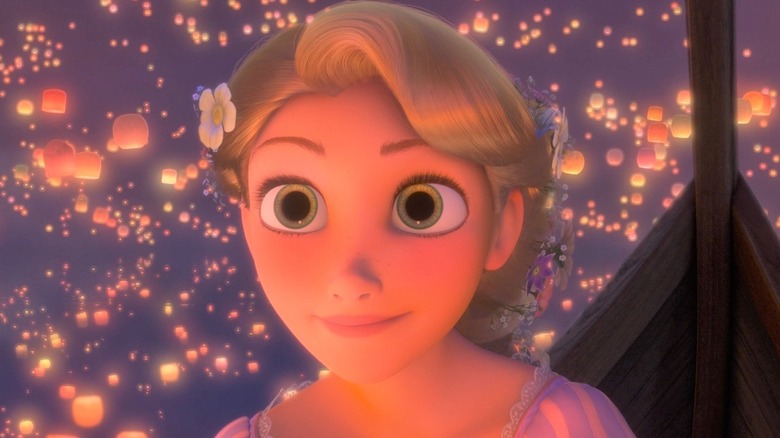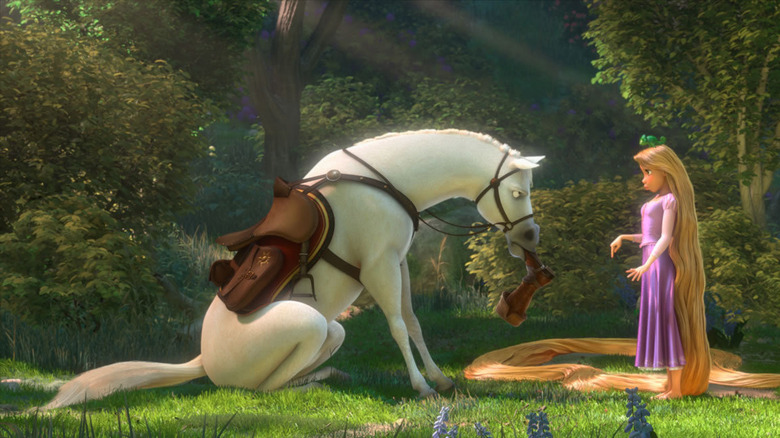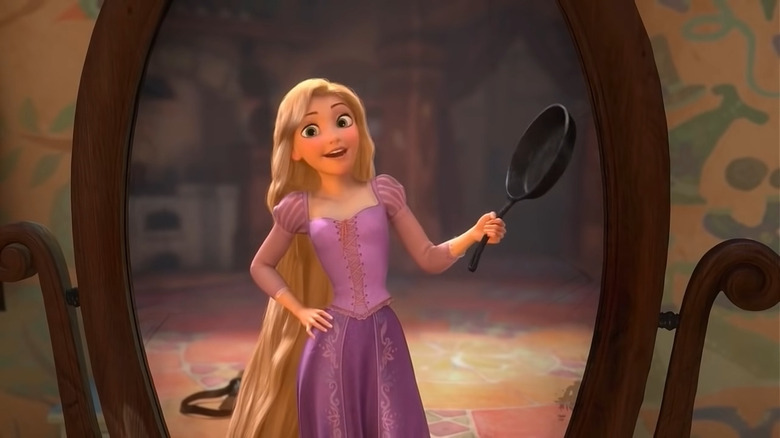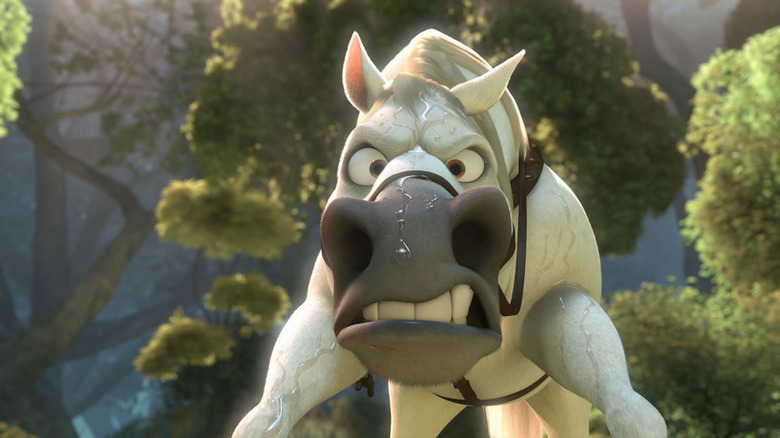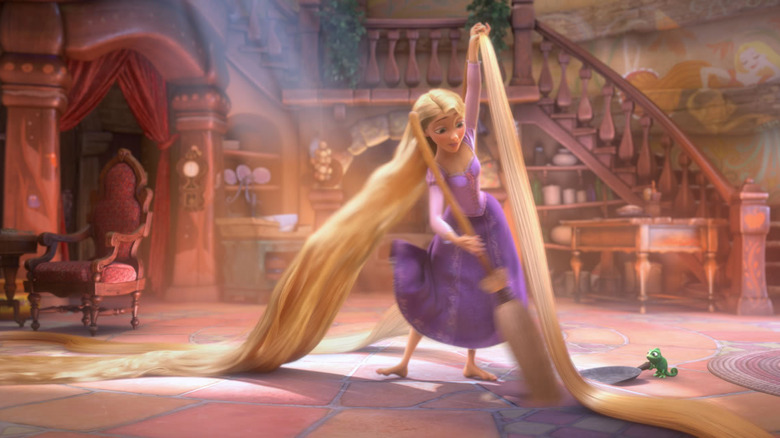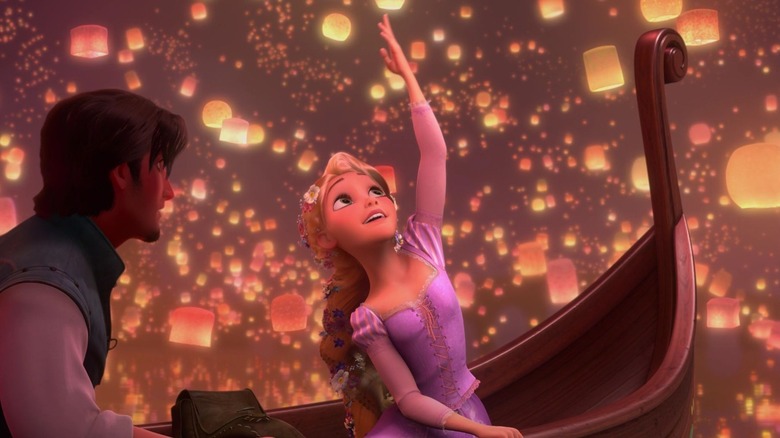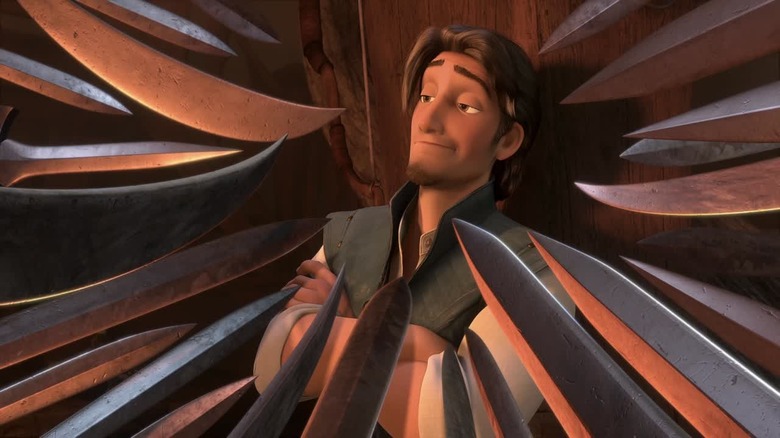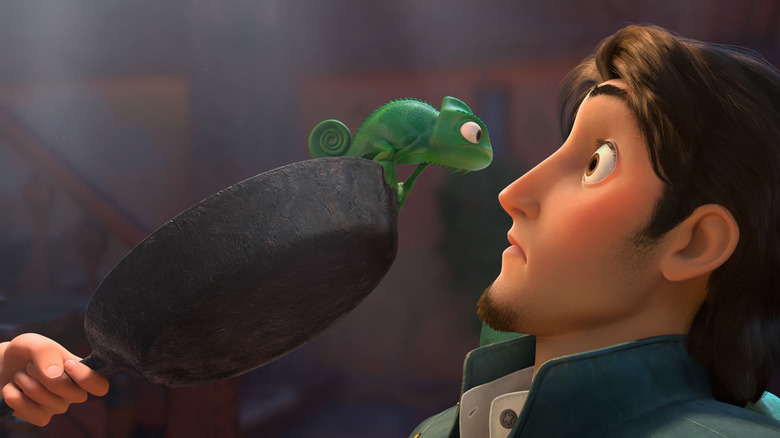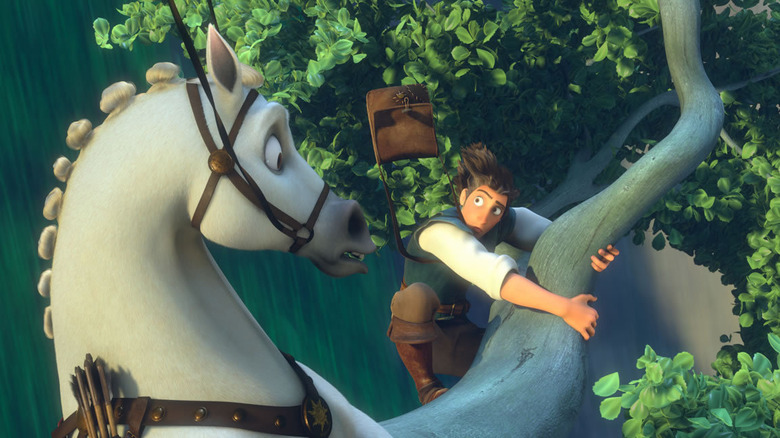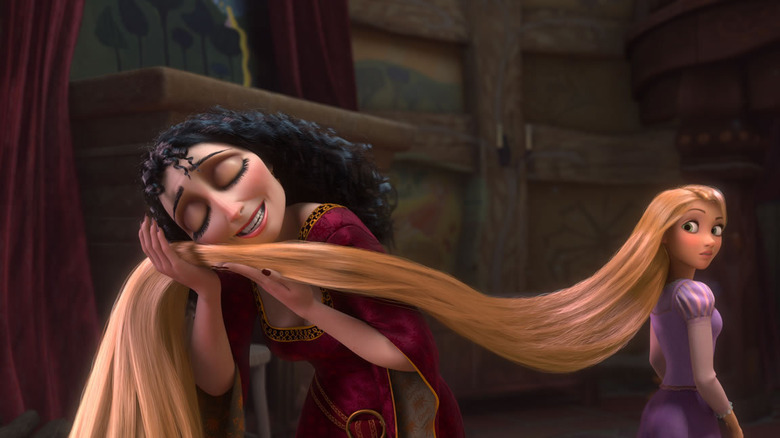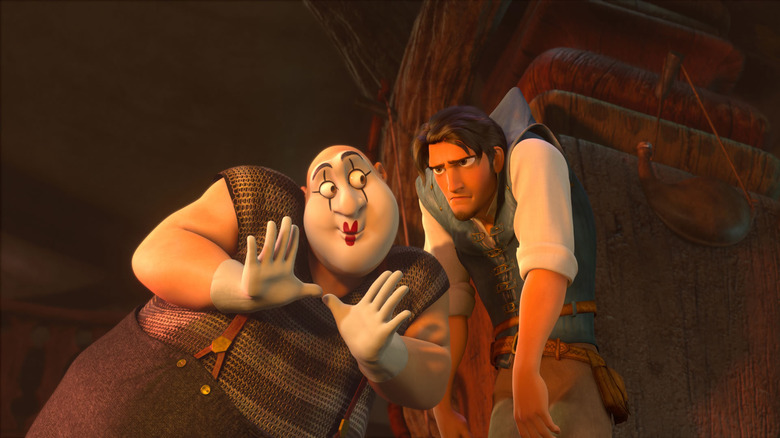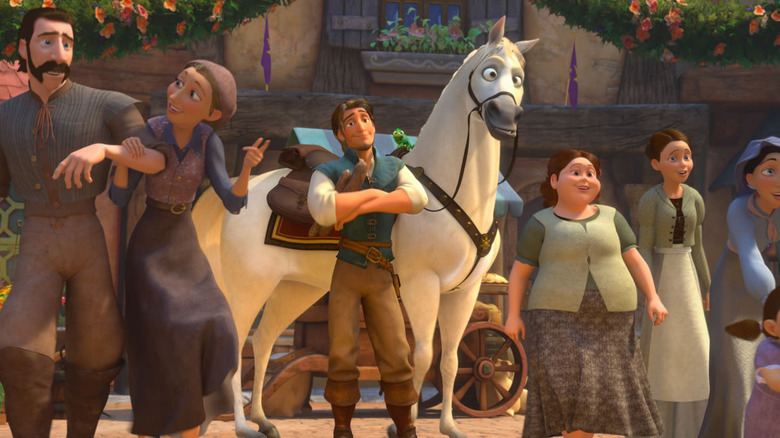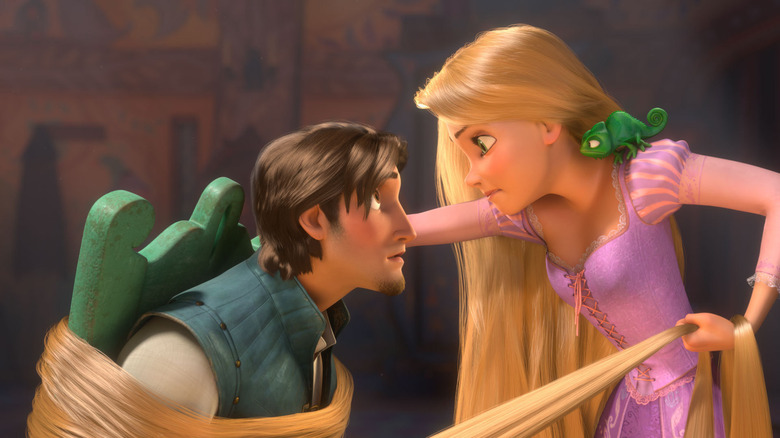The Untold Truth Of Tangled
While the 2013 Disney film "Frozen" is widely credited with kicking the reappreciation for fairy tale musicals into high gear, the role of "Tangled" in getting people to love old-school animated Disney movies again can't be understated.
The first computer-animated fairy tale musical released by Disney, "Tangled" went against the grain of 2000s family fare, which largely took a cue from "Shrek" in casting a snarky post-modern eye on movies like "Beauty and the Beast" and "Cinderella." "Tangled" made its concessions to the demands of modern moviegoers, including realizing its tale in computer animation, but it also proved charming enough to remind people why they liked these kinds of movies in the first place. Released the same year that the box office of "Shrek Forever After" indicated audiences were done with this wry ogre, "Tangled" merged the old and the new in an exciting way that would pave a path for the likes of "Frozen" and "Moana."
Though "Tangled" is now a beloved part of the Walt Disney Animation Studios canon, the film's road to the big screen wasn't an easy one. In fact, the film faced an avalanche of problems getting to its final form, including animator Glen Keane's original vision for the film and the difficulties in animating Rapunzel's endless locks. It wasn't always easy bringing "Tangled" to life, but the untold truth of this fantasy film reflects all the passion that went into this project and informed its remarkable quality.
Tangled was originally Glen Keane's baby
As noted by director Nathan Greno in a DVDizzy interview, the Rapunzel fairy tale had a long history at Disney Animation, dating back to Walt Disney eyeballing the story for a feature film in the 1940s. However, the feature that would come to be known as "Tangled" started its life as a passion project of Glen Keane. An iconic Disney animator, Keane was looking to leap into directing feature films. Speaking to DVDizzy, Keane revealed that he opted to make that directorial debut about Rapunzel because she was a human who could do something that was impossible — the perfect entity to realize through animation.
As recounted by JimHillMedia, Keane gave a presentation in 2005 where he noted that his initial pitch to Disney about a Rapunzel movie went over great ... except the studio wanted it done in CGI. Keane was a veteran of hand-drawn animation and had long professed his enduring dedication to the art form. Now, he was having to learn every detail about these new tools to bring his passion project to life. Still, even if Keane wasn't working in a medium he was familiar with, this filmmaker still had concrete visual goals in mind for "Rapunzel," particularly in making something exceptionally beautiful to look at. "Rapunzel" would look like no other CG-animated film before it, an ambitious goal that fueled the feature's long road to completion.
The earliest production problems on Tangled
The earliest version of "Tangled" directed by Glen Keane was constantly plagued with problems. The film was constantly oscillating between being a parody of Disney fairy tale musicals and doing something much more straightforward, with a significant regime change at Walt Disney Animation Studios during its production not doing things any favor. In April 2007, an attempt was made to get the project back on track by hiring a new co-director for what was then known as "Rapunzel." Dean Wellins was tasked with helping to shepherd the project and get it back on track.
The biggest problem this original version of "Rapunzel" fell into was related to its story. Specifically, Disney Animation brass were concerned that Keane's vision for "Rapunzel" lacked a strong enough second and third act to captivate viewers. Given that Keane had originated this project, not to mention his high status within the halls of Disney Animation, there was hope that he could straighten everything out and make "Rapunzel" the next Disney Animation classic. Unfortunately, these early issues were a harbinger of even greater production problems to come, with neither Keane nor Wellins managing to last as directors on the feature through its final form.
Glen Keane's feelings on how the film turned out
In 2008, the news came down that director Glen Keane (along with co-director Dean Wellins) was no longer in charge of "Rapunzel." The production would now be handled by Bryon Howard and Nathan Greno, who'd just wrapped up "Bolt" for Walt Disney Animation Studios. By the time the film was finally released as "Tangled," Keane revealed to Collider that he'd stepped away from his directorial duties because of a heart attack. Losing full control of a passion project like this one could've been immeasurably devastating, but Keane felt fine about how everything went down since he remained a part of "Tangled" as its executive producer and a consultant on its animation.
Talking to Animation World Network, Keane further noted that he felt alright about handing off "Tangled" to Greno and Howard, partially because they ended up connecting with the material on such a deep and personal level. He also noted that he still wound up working on and contributing to the final product in ways that made him feel proud and excited. Even better, he felt that the visuals in the film's final cut unquestionably lived up to his ambitions of making CG more like hand-drawn animation. "Tangled" wasn't the film Keane set out to make, but it still ended up impressing him and leaving him fulfilled as an artist.
Why Mandy Moore pursued the role of Rapunzel
Mandy Moore's career as a singer and actor has taken her to a lot of interesting places, but few have been quite as high-profile as getting to voice Rapunzel in "Tangled." With this part, Moore wasn't just playing the protagonist of a potentially massive family movie. She was also cementing herself as a part of the world-famous Disney Princess canon, placing her alongside eternally relevant characters like Cinderella and Snow White. The pressure that comes with those sorts of achievements might throw off other performers or ward them away from the role. However, Moore knew exactly what she was in for whenever she opted to pursue the lead role of "Tangled."
Talking to Collider, Moore divulged that she'd been a longtime fan of classic Disney musicals like "The Little Mermaid" and "Beauty and the Beast." Considering how much those features shaped her life, Moore had to jump at the chance to be a part of "Tangled." To secure the role of Rapunzel, though, she had to go through an extensive auditioning process. This was a trying aspect of the production, but it ended on a happy note since Moore snagged the part. With this development, Moore was able to fulfill her lifelong dream of being a part of the movies that had brought so much joy into her life.
Mandy Moore's musical challenges
Having gotten her start as a singer on albums like "So Real," Mandy Moore has no shortage of experience when it comes to being a singer. But the tunes of "Tangled" weren't just pop ditties — they were classical show tunes meant to progress the story of a musical along. In other words, this style of song was an entirely different beast, something Moore freely admitted in an interview with Collider. Moore noted that this was the first time she sang as a character rather than just singing as herself on one of her albums. This meant she had to remember to stay in character while she was belting out the various tunes of "Tangled," which required finding small ways in her vocal deliveries to remind people of Rapunzel's personality.
Evidently, Moore considered singing in character even more difficult than delivering Rapunzel's dialogue, though doing all this singing did have a massive upside for a die-hard Disney fan like Moore. She often got to work with composer Alan Menken ("The Little Mermaid," "Aladdin," "Beauty and the Beast") in recording sessions for "Tangled," a surreal experience for this performer. Beyond just being a dream come true as a Disney geek, interacting with Menken also helped Moore figure out the finer nuances of how to deliver her musical numbers properly. Though the songs of "Tangled" were doubtlessly challenging for Moore, there were also tools in place for her to get over these hurdles.
How the film brought 2D animation to the world of CGI
From the very start of its production, "Tangled" was meant to be something different from an ordinary computer-animated movie. Specifically, original director Glen Keane wanted this film to emulate hand-drawn animation and painterly textures more than, say, "Shrek." Even once the film changed directors and Byron Howard and Nathan Greno took over the production, the visual ambitions of "Tangled" were maintained.
An in-depth breakdown by Senses of Cinema helpfully showcases the various ways aspects of 2D animation made their way into the computer-animated world of "Tangled." Specifically, subtle body movements throughout the feature, such as a guard slowly realizing he's been conned by Rider, adhere to stylized tendencies of hand-drawn characters rather than realistic human behaviors. Similarly, the way parts of certain characters — especially their heads — squash and stretch in moments of intense movement also echo classic hand-drawn animation details rather than the rigid shapes associated with computer animation.
It's impossible to know if these are the manifestations of hand-drawn animation attributes in CGI that Keane had in mind when he first imagined the movie that would become "Tangled." However, at least on a conceptual level, the final cut of "Tangled" does live up to Keane's vision for merging the best of these animated worlds.
Where did Pascal the chameleon come from?
Like so many Disney princesses, Rapunzel has an animal sidekick/best friend that also doubles as a reliable source of comic relief. The character filling all those roles in "Tangled" is Pascal the chameleon, a mischievous critter who's always focused on making sure that Rapunzel is safe and taken care of. Talking to DVDizzy, director Byron Howard noted that Pascal's entire existence was due to the film needing to give Rapunzel someone she could converse with while she was trapped in her tower, which led to the idea of giving her an animal companion.
Once this notion was settled, everyone involved wanted to eschew giving her a safe or familiar animal, like a furry woodland critter, as a pal. Eventually, a chameleon was chosen since it felt like a fittingly offbeat pet for a character who breaks the norms like Rapunzel. Howard also noted that Pascal emerged as a byproduct of his and fellow director Nathan Greno's affection for great physical comedians like Buster Keaton or Charlie Chaplin. A silent character like Pascal allowed them to channel those legends with some hysterical physical comedy. Though he may seem like just the latest cute Disney cartoon sidekick, Pascal ended up fulfilling many different needs on the part of the film's creative team.
How Flynn Rider's design was finalized
It takes a lot of effort to get human designs just right in computer animation. That was the challenge facing movies like "The Incredibles" in the earliest days of the medium — how to get people to look just right without immediately lapsing into the uncanny valley. By 2010, CG humans had become a bit more reliable in not immediately turning moviegoers away. Technology had come far enough to allow digital humans to even look attractive. There was no better reflection of this than "Tangled," which set out to make sure that its CG male lead, Flynn Rider (Zachary Levi), was as conventionally handsome as possible.
To achieve this, some research was required. Talking to Independent.ie, "Tangled" director Nathan Greno recalled how they decided to nail down Rider's design by asking all the ladies at Walt Disney Animation Studios to come into a meeting and bring images of who they believed were the most attractive men in Hollywood. Once this meeting was underway, the women proceeded to pinpoint the flaws in these Hollywood hunks so that Gren and Bryon Howard would know what not to do when designing the character of Rider. It may have been an unorthodox route to take, but it ended up working out fantastically with regards to Rider's design, not to mention emphasizing how far CG tools had come in allowing such gorgeous human beings to be realized.
The problem with animating Rapunzel's hair
It can be very interesting to figure out what is and isn't complicated to realize in computer-generated imagery. Sometimes, it's the simplest things that can prove to be a challenge, like fur or even just human skin acting like human skin. For "Tangled," a massive issue that came up was hair — specifically, Rapunzel's long blonde locks. Simply put, the character's hair was a massive obstacle to realize.
In a breakdown of Rapunzel's hair for NPR, it was revealed that one critical thing about Rapunzel's hair was to make it look realistic but not have it behave super realistically. As pointed out by senior software designer Kelly Ward, if Rapunzel's hair acted like it was supposed to, this woman would be dragging nearly 100 pounds of hair around daily! Juggling a sense of visual tangibility with a necessary stylized quality was crucial to getting this character just right. Luckily, Ward's experience in hair modeling in college, as well as the advanced technology at Walt Disney Animation Studios, helped overcome some of the endless challenges that came from realizing Rapunzel's hair in CGI.
Alan Menken's experience returning to animated musicals
Throughout the 1990s, Alan Menken was a staple of Disney's various animated musicals. Partnered with a variety of different songwriters (including Stephen Schwartz and the late Howard Ashman), Menken helped create some of the most beloved tunes in the entire Disney canon. But after the 1997 feature "Hercules," Menken's presence in Walt Disney Animation Studio fare vanished, save for the 2004 title "Home on the Range." The studio turned to other songwriters for movies like "Tarzan" and "The Princess and the Frog" while many 2000s Disney Animation projects weren't even musicals.
Menken returned to the Disney Animation fold with "Tangled" (though, shortly before that, he'd composed the score for the 2007 animation/live-action Disney hybrid "Enchanted") by pairing up with songwriter Glenn Slater to deliver a swath of catchy new ditties. Speaking to Variety, Menken noted that the biggest challenge he had in working on "Tangled" was figuring out what a fairy tale musical in the year 2010 sounded like. This led Menken and Slater to decide that the songs should evoke artists like Joni Mitchell and Cat Stevens. Menken pinpointed that a "yearning for freedom" quality in those tunes also made them a perfect influence for the story of Rapunzel. While it had been a while since Menken had done a full-blown animated musical for Disney, these creative touches indicated he'd never lost that imaginative spark that made him a legend in the first place.
Why did Rapunzel change its name to Tangled?
In April 2010, just before its marketing campaign began, "Rapunzel" was hit with a major change — the film would be now called "Tangled." The alteration was met with widespread controversy, particularly since it came on the heels of "The Princess and the Frog" doing only decent business at the box office. Reports ran rampant that Disney brass were convinced a movie with "princess" in the title didn't attract a wide enough audience, particularly with male viewers. Thus, Disney opted to adopt the name "Tangled" to improve this new musical's chances at box office glory by deemphasizing the princess angle it would've had with "Rapunzel."
The concept of changing a movies title just to appease male audience members didn't go over well with the general public. However, just before the film's release, directors Bryan Howard and Nathan Greno clarified to Entertainment Weekly that the real reason "Rapunzel" switched its name to "Tangled" was to show that Rapunzel wasn't the only lead character of the movie and to reflect the complicated dynamic between Rapunzel and Flynn Rider. Years later, though, former Disney Animation head John Lasseter would confirm (via The Telegraph) that "The Princess and the Frog's" financial struggles and a perceived bias from male audiences against princess movies did play a role in renaming "Rapunzel."
The tremendously important box office of Tangled
Walt Disney Animation Studios hadn't had a big hit in a while circa. 2010. Granted, the studio had regained some of its footing from the box office nadir days of "Home on the Range" and "Treasure Planet." However, the likes of "Bolt" and "The Princess and the Frog" still weren't making the same kind of money as your average Pixar or DreamWorks Animation feature. This put pressure on "Tangled" to reverse this box office course. Could a big, old-fashioned Disney musical told in modern computer animation resonate with audiences and restore some of the company's box office luster? It turned out that "Tangled" would do that and so much more in its impressive theatrical run.
Worldwide, "Tangled" grossed $584 million, $200 million of which came from North America. That domestic performance was especially important because that made "Tangled" the third-highest-grossing Disney Animation title at the time in this territory, only behind "The Lion King" and "Aladdin." It also marked only the second feature from the studio, after "Tarzan," to exceed $150 million domestically since "The Lion King" in 1994. Even better, among 2010 animated movies, it managed to globally outgross features from several of its rivals, such as "How to Train Your Dragon" and "Despicable Me." "Tangled" was a massive winner at the box office for Walt Disney Animation Studios, the kind it hadn't experienced in decades.
